COVID-19: TCTMD’s Dispatch for September Week 5
We’re curating a list of COVID-19 research and other useful content, and updating it regularly.

Since March 2020, TCTMD reporter Todd Neale has been writing up breaking news and peer-reviewed research related to COVID-19 every weekday. In July 2021, we transitioned to Mondays, Wednesdays, and Fridays. If you have something to share, tell us. All of our COVID-19 coverage can be found on our COVID-19 Hub.
October 1, 2021
Molnupiravir, an investigational oral antiviral medication developed by Merck and Ridgeback Biotherapeutics, nearly halves the risk of hospitalization or death in nonhospitalized adults with mild-to-moderate COVID-19, according to a press release from the companies. In an interim analysis of the MOVe-OUT phase III trial, the rate of that combined outcome through 29 days was 7.3% in patients treated with the antiviral and 14.1% in those who received placebo; there were no deaths on active treatment and eight on placebo. Merck said it plans to apply for an emergency use authorization from the US Food and Drug Administration as soon as possible.
Among outpatients with COVID-19 and risk factors for severe disease, REGEN-COV, which combines the monoclonal antibodies casirivimab and imdevimab, lowered the rate of COVID-19-related hospitalization or death (1.3% vs 4.6%; P < 0.001), according to phase III results published Wednesday in the New England Journal of Medicine. Time to resolution of symptoms was 4 days shorter on active treatment versus placebo. A week ago, the World Health Organization (WHO) recommended the treatment for patients with nonsevere COVID-19 who have a risk of hospitalization over 10%, as well as for those with severe or critical disease with seronegative status. CIDRAP News has more.
 Meanwhile, anti-inflammatory drugs approved for the treatment of arthritis, vasculitis, and other inflammatory rheumatoid and musculoskeletal diseases are in short supply in Europe, because stocks are being redirected for the treatment of severe COVID-19, the BMJ reports. Drugs in demand include tocilizumab, a humanized monoclonal antibody, and dexamethasone, a glucocorticoid.
Meanwhile, anti-inflammatory drugs approved for the treatment of arthritis, vasculitis, and other inflammatory rheumatoid and musculoskeletal diseases are in short supply in Europe, because stocks are being redirected for the treatment of severe COVID-19, the BMJ reports. Drugs in demand include tocilizumab, a humanized monoclonal antibody, and dexamethasone, a glucocorticoid.
A phase III trial conducted among adults in the United States, Chile, and Peru showed an overall estimated vaccine efficacy of 74.0% against symptomatic and severe COVID-19 with two doses of the vaccine from Oxford/AstraZeneca; that figure was higher (83.5%) in participants 65 and older. Estimated efficacy for preventing SARS-CoV-2 infection was 64.3%. Results are published in the NEJM; a Reuters story provides more details.
Next month, Australia will lift an 18-month ban on its citizens traveling abroad, Reuters reports. Vaccinated people will be allowed to quarantine at home upon return, whereas those who have not received a vaccine will have to quarantine in a hotel. “It's time to give Australians their lives back. We've saved lives,” Prime Minister Scott Morrison said at a media conference. “We've saved livelihoods, but we must work together to ensure that Australians can reclaim the lives that they once had in this country.”
Israel has seen very few myocarditis cases associated with booster doses of the Pfizer/BioNTech vaccine, according to data released by the country’s health ministry late Thursday (Reuters). After millions of third doses have been administered to people older than 12, just nine cases have been reported, all in males—three were in those aged 16 to 29 and the rest were in those ages 30 to 59. There are eight possible cases still under review.
India is implementing travel restrictions on UK citizens in response to limits placed on Indian nationals by the UK, Reuters reports. British people who visit India will be required to quarantine even if they are fully vaccinated. “The new rules, which take effect from Monday, follow the UK decision to require Indians vaccinated with AstraZeneca's Covishield to quarantine.” Meanwhile, England saw the prevalence of COVID-19 increase in the week ending September 25, driven by infections in school-age children.
The safety committee of the European Medicines Agency (EMA) has weighed in on several issues related to COVID-19 vaccine side effects. It concluded that there is a possible link between the Janssen vaccine (Johnson & Johnson) and rare cases of venous thromboembolism; recommended adding immune thrombocytopenia as an adverse reaction of unknown frequency to the labels of the Janssen vaccine and the one from Oxford/AstraZeneca; and agreed on direct healthcare professional communications regarding these issues.
 Despite being less hesitant about getting a COVID-19 vaccine, people with disabilities are less likely to actually get a shot than are adults without a disability, according to US survey data published in Morbidity and Mortality Weekly Report. “Public health efforts that make COVID-19 vaccination information, scheduling, and sites more easily accessible for persons with disabilities might help to address health inequities and increase vaccination demand and coverage,” the authors say.
Despite being less hesitant about getting a COVID-19 vaccine, people with disabilities are less likely to actually get a shot than are adults without a disability, according to US survey data published in Morbidity and Mortality Weekly Report. “Public health efforts that make COVID-19 vaccination information, scheduling, and sites more easily accessible for persons with disabilities might help to address health inequities and increase vaccination demand and coverage,” the authors say.
COVID-19 vaccination mandates for healthcare workers and other employees seem to be working, the New York Times reports, pointing to rising numbers of people getting their shots in California and New York, where such requirements have gone into effect. Contrary to fears that mandates would exacerbate staffing shortages, “so far, a number of early mandates show few indications of large-scale resistance.”
The US Centers for Disease Control and Prevention (CDC) urged pregnant people to get vaccinated against COVID-19 in a new alert sent out Wednesday. “CDC strongly recommends COVID-19 vaccination either before or during pregnancy because the benefits of vaccination outweigh known or potential risks,” the agency said, noting that as of Monday, there have been more than 125,000 confirmed infections, 22,000 hospitalizations, and 161 deaths among pregnant women.
 There will be “severe restrictions” on the movements of athletes and spectators at the 2022 Winter Olympics in Beijing, China, which are slated for February, the New York Times reports: “The Beijing Olympic and Paralympic Games will take place in what organizers called a ‘closed-loop management system,’ a bubble-like environment in which athletes, officials, broadcasters, journalists, and a large Games workforce will be forced to eat, sleep, work, and compete, without leaving, from the day they arrive to the moment they depart.” Only people from mainland China will be allowed to attend the Games as spectators.
There will be “severe restrictions” on the movements of athletes and spectators at the 2022 Winter Olympics in Beijing, China, which are slated for February, the New York Times reports: “The Beijing Olympic and Paralympic Games will take place in what organizers called a ‘closed-loop management system,’ a bubble-like environment in which athletes, officials, broadcasters, journalists, and a large Games workforce will be forced to eat, sleep, work, and compete, without leaving, from the day they arrive to the moment they depart.” Only people from mainland China will be allowed to attend the Games as spectators.
September 29, 2021
Reuters provides a roundup of COVID-19 news: a study shows that at least one long-term symptom was seen in 37% of patients after they were infected with the virus; at least 400,000 Americans have received booster doses of the Pfizer/BioNTech vaccine after they were cleared by regulators; daily case numbers have spiked in New Zealand, with 45 new cases reported in Auckland; the number of new daily cases in Poland has topped 1,000 for the first time; Russia is struggling to sell its Sputnik V vaccine in India; and Slovenia temporarily suspended use of the Janssen vaccine from Johnson & Johnson after the death of a young women, while Switzerland just agreed to buy 150,000 doses of the same vaccine.
Amid falling COVID-19 numbers, Japan is set to lift its state of emergency this week, the AP reports: “Prime Minister Yoshihide Suga said the emergency will end Thursday and virus restrictions will be eased gradually ‘in order to resume daily lives despite the presence of the virus.’”
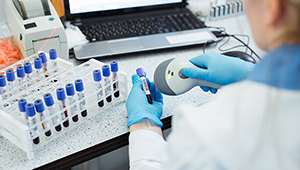 As the COVID-19 pandemic wore on in New York City last year, patient demographics and outcomes shifted, though one thing stayed constant—the link between troponin and mortality, a study in the Journal of the American College of Cardiology shows. Despite an overall decrease in death rates, this association only grew stronger as spring progressed into fall, TCTMD’s Caitlin Cox reports.
As the COVID-19 pandemic wore on in New York City last year, patient demographics and outcomes shifted, though one thing stayed constant—the link between troponin and mortality, a study in the Journal of the American College of Cardiology shows. Despite an overall decrease in death rates, this association only grew stronger as spring progressed into fall, TCTMD’s Caitlin Cox reports.
The New York Times reports that a vaccine mandate for healthcare workers in New York State “appears to have pressured thousands of holdouts to receive last-minute shots, though hospitals and nursing homes continue to brace for potential staffing shortages should the mandate fall short, according to state and industry officials.” When the mandate went into full effect on Monday, 92% of hospital and nursing home workers had received at least one shot, a jump of 8% to 10% from the week before. Elsewhere, Novant Health in North Carolina, which has roughly 35,000 employees, fired about 175 who failed to get vaccinated, “one of the largest-ever mass terminations due to a vaccine mandate,” according to the Washington Post. The AP has more on fears of staffing shortages at hospitals across the US as deadlines to get vaccinated approach.
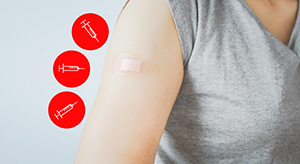 No unusual patterns of adverse reactions have been detected after a third dose of an mRNA COVID-19 vaccine, according to early data in Morbidity and Mortality Weekly Report. Local or systemic reactions were reported by 79.4% and 74.1%, respectively, after the booster dose; the numbers after the second of the two initial doses were 77.6% and 76.5%.
No unusual patterns of adverse reactions have been detected after a third dose of an mRNA COVID-19 vaccine, according to early data in Morbidity and Mortality Weekly Report. Local or systemic reactions were reported by 79.4% and 74.1%, respectively, after the booster dose; the numbers after the second of the two initial doses were 77.6% and 76.5%.
Mortality is very high in patients with cerebral venous sinus thrombosis (CVST) associated with vaccine-induced immune thrombotic thrombocytopenia (VITT) brought on by COVID-19 vaccination, a study in JAMA Neurology affirms. The in-hospital mortality rate was 47% in this group, 5% in patients with CVST but not VITT, and 3.9% in patients who presented with CVST before the pandemic. Mortality among patients with CVST and VITT fell as awareness of the condition grew in the scientific community.
Pfizer and BioNTech have submitted initial data on use of their COVID-19 vaccine in children ages 5 to 12 to the US Food and Drug Administration (FDA), but they have not yet applied for an emergency use authorization, the companies announced Tuesday. They recently announced positive top-line results from a phase II/III trial in this age group. In older kids ages 12 to 15, the vaccine was protective during a Delta-driven outbreak in Israel, according to a study in Emerging Infectious Diseases.
The US National Institute of Allergy and Infectious Diseases (NIAID) has given about $36.3 million to three academic centers with the aim of developing vaccines that will protect against multiple types of coronaviruses and variants. “The awards are intended to fuel vaccine research for a diverse family of coronaviruses, with a primary focus on potential pandemic-causing coronaviruses, such as SARS-CoV-2.”
Cannabis use during pregnancy rose during the COVID-19 pandemic among women living in northern California, from 6.75% to 8.14% of pregnancies, according to a research letter in JAMA. “Prenatal cannabis use is associated with health risks, including low infant birth weight and potential effects on offspring neurodevelopment,” the authors note. “Clinicians should educate pregnant women about the harms of prenatal cannabis use, support women to quit, and provide resources for stress reduction.”
 Current smokers have greater risks of COVID-19 hospitalization and death compared with those who have never smoked, a study in Thorax confirms. The results were consistent in observational and mendelian randomization analyses, which supports “a causal effect of smoking on risk of severe COVID-19,” the researchers say.
Current smokers have greater risks of COVID-19 hospitalization and death compared with those who have never smoked, a study in Thorax confirms. The results were consistent in observational and mendelian randomization analyses, which supports “a causal effect of smoking on risk of severe COVID-19,” the researchers say.
September 27, 2021
 COVID-19 has reduced life expectancy across a wide swath of countries, most notably the United States and Lithuania, an analysis of 29 countries concludes. In the International Journal of Epidemiology, researchers report that life expectancy at birth declined from 2019 to 2020 in 27 out of 29 countries studied, with men in the US and Lithuania seeing the largest declines (2.2 and 1.7 years, respectively). “But reductions of more than an entire year were documented in 11 countries for males and eight among females,” they write. “The COVID-19 pandemic triggered significant mortality increases in 2020 of a magnitude not witnessed since World War II in Western Europe or the breakup of the Soviet Union in Eastern Europe.”
COVID-19 has reduced life expectancy across a wide swath of countries, most notably the United States and Lithuania, an analysis of 29 countries concludes. In the International Journal of Epidemiology, researchers report that life expectancy at birth declined from 2019 to 2020 in 27 out of 29 countries studied, with men in the US and Lithuania seeing the largest declines (2.2 and 1.7 years, respectively). “But reductions of more than an entire year were documented in 11 countries for males and eight among females,” they write. “The COVID-19 pandemic triggered significant mortality increases in 2020 of a magnitude not witnessed since World War II in Western Europe or the breakup of the Soviet Union in Eastern Europe.”
The European Medicines Agency (EMA) has launched an evaluation of the need for a 6-month booster for people ages 12 and older who received the Spikevax (Moderna) vaccine. The agency’s human medicines committee “will carry out an accelerated assessment of data submitted by the company that markets Spikevax (Moderna), including results from an ongoing clinical trial,” a press release states. The announcement notes that the EMA and the European Centre for Disease Prevention and Control have recently stated their position on vaccine booster doses, concluding that they do not consider these to be urgent for the general population.
US President Joe Biden got his Pfizer/BioNTech booster Monday, the New York Times reports, following US Food and Drug Administration (FDA) approval for boosters for this specific vaccine last week. NPR explores the open questions surrounding whether a similar regulatory decision is likely or needed for the Moderna and Johnson & Johnson (Janssen) vaccines.
An analysis tracking the “trajectory” of vaccine hesitancy has found that almost one-third of people surveyed who said they were “very unlikely,” “unlikely,” or “unsure” about getting a COVID-19 vaccine back in the fall of 2020 had received at least one dose by late April 2021. An additional 37% said they were likely to get vaccinated, but 32% remained unlikely to do so. “Vaccine hesitancy is waning, yet inequities in receipt remain,” researchers write in JAMA Network Open. “There is a clear public health opportunity to convert higher vaccine willingness into successfully delivered vaccinations.”
 An analysis of all children admitted to Canadian hospitals with acute SARS-CoV-2 infection between April 8 and December 31, 2020, shows that more than one-third were incidental diagnoses, researchers report in CMAJ. In all, 56.8% of admissions were directly related to COVID-19 and of these, just 34.7% had critical disease. Most required only supportive care, with just 28% of those hospitalized requiring respiratory or hemodynamic support. As other series have shown, obesity and neurologic and respiratory comorbidities were associated with more-severe disease. Among the 150 pediatric cases hospitalized because of COVID-19, fewer than five died.
An analysis of all children admitted to Canadian hospitals with acute SARS-CoV-2 infection between April 8 and December 31, 2020, shows that more than one-third were incidental diagnoses, researchers report in CMAJ. In all, 56.8% of admissions were directly related to COVID-19 and of these, just 34.7% had critical disease. Most required only supportive care, with just 28% of those hospitalized requiring respiratory or hemodynamic support. As other series have shown, obesity and neurologic and respiratory comorbidities were associated with more-severe disease. Among the 150 pediatric cases hospitalized because of COVID-19, fewer than five died.
The American Heart Association (AHA) issued a reminder that everyone over 6 months of age can get their annual flu shot, noting that anyone eligible can get their COVID-19 vaccine at the same visit. “Flu and COVID-19 are both serious respiratory illnesses, and people living with chronic lung disease, cancer, heart disease, and diabetes are at a higher risk for severe complications,” a press release states. “Both the flu vaccine and the COVID-19 vaccines are safe for people with chronic health conditions and are proven to provide the best protection against life-threatening complications from the two different viruses.”
Last Friday, the AHA issued a separate statement reminding professionals and the public that the US Centers for Disease Control & Prevention (CDC) had recommended a third dose of the Pfizer/BioNTech vaccine after a 6-month gap for adults 65 and older, as well as those ages 50 to 64 with health conditions that increase their risk for severe infection. The FDA had approved the booster earlier in the week. Other people may also be eligible based on preexisting conditions or work exposures, the AHA notes.
The US Centers for Medicare and Medicaid Services (CMS) announced last week that it will be providing coverage for vaccines and booster doses without cost-sharing. “Beneficiaries with Medicare pay nothing for COVID-19 vaccines or their administration, and there is no applicable copayment, coinsurance, or deductible,” a press release spells out.
Reassuringly, perhaps, a comparison of COVID-19 deaths among patients eligible for Medicare versus those too young to qualify found that Medicare eligibility was not associated with increased deaths during the COVID-19 pandemic. “These null findings may reflect the influence of state and federal policies that directed payments to hospitals for COVID-19 treatment and eliminated cost-sharing for COVID-19 testing, both of which aimed to broaden access to COVID-19 testing and treatment,” investigators conclude in JAMA Health Forum.
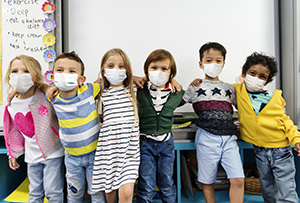 In Morbidity and Mortality Weekly Report, investigators looking at school-associated outbreaks in Arizona conclude that schools without kindergarten-to-grade-12 mask mandates were 3.5 times more likely to have COVID-19 outbreaks than schools that started the year with mask requirements. A separate MMWR paper by CDC researchers, using data from July 1 to September 4, 2021, found that counties across the United States that did not have school mask requirements experienced larger increases in pediatric COVID-19 case rates after schools reopened, compared with counties that had school mask mandates in place. “School mask requirements, in combination with other prevention strategies, including COVID-19 vaccination, are critical to reduce the spread of COVID-19 in schools,” they conclude.
In Morbidity and Mortality Weekly Report, investigators looking at school-associated outbreaks in Arizona conclude that schools without kindergarten-to-grade-12 mask mandates were 3.5 times more likely to have COVID-19 outbreaks than schools that started the year with mask requirements. A separate MMWR paper by CDC researchers, using data from July 1 to September 4, 2021, found that counties across the United States that did not have school mask requirements experienced larger increases in pediatric COVID-19 case rates after schools reopened, compared with counties that had school mask mandates in place. “School mask requirements, in combination with other prevention strategies, including COVID-19 vaccination, are critical to reduce the spread of COVID-19 in schools,” they conclude.
Researchers writing in the Lancet have looked at whether the International Health Regulations (IHR), which came into effect in 2005, have been functioning sufficiently during the pandemic. The aim of the IHR is to provide a new legal framework to detect, prevent, and contain global health risks, the authors note, but it has a limited mandate. Their review concludes that the IHR functioned appropriately in terms of its COVID-19 response, but that “many countries only applied the IHR in part, were not sufficiently aware of these regulations, or deliberately ignored them, and that WHO [the World Health Organization] did not make full use of the powers given to it through the wording and spirit of the IHR. Thus, the IHR are not deficient, but their implementation by member states and by WHO was inadequate.” The group has previously set out recommendations to strengthen IHR implementation.
In 2019, the United States saw its biggest jump in homicides since a national registry was started back in 1960. “The significant rise in homicides has roughly coincided with the 18 months of the COVID-19 pandemic,” the New York Times reports. “The high murder rate has continued into 2021, although the pace has slowed as the year has progressed.” Major crimes, overall, declined during the same period, but gun sales have spiked.
Todd Neale is the Associate News Editor for TCTMD and a Senior Medical Journalist. He got his start in journalism at …
Read Full Bio


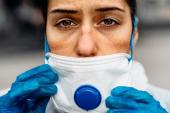

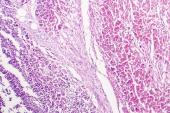
Comments